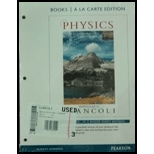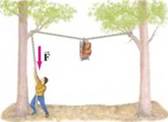
Physics
7th Edition
ISBN: 9780321929013
Author: Douglas C. Giancoli
Publisher: PEARSON
expand_more
expand_more
format_list_bulleted
Concept explainers
Textbook Question
thumb_up100%
Chapter 9, Problem 8P
The two trees in Fig. 9-51 are 6.6 m apart. A backpacker is trying to lift his pack out of the reach of bears. Calculate the magnitude of the force F that he must exert downward to hold a 19-kg backpack so that the rope sags at its midpoint by (a) 1.5 m, (b) 0.15 m.

Figure 9-51
Expert Solution & Answer
Want to see the full answer?
Check out a sample textbook solution
Students have asked these similar questions
No chatgpt pls will upvote
No chatgpt pls will upvote
Solve and answer the question correctly please. Thank you!!
Chapter 9 Solutions
Physics
Ch. 9 - Prob. 1OQCh. 9 - Describe several situations in which an object is...Ch. 9 - Prob. 2QCh. 9 - You can find the center of gravity of a meter...Ch. 9 - Prob. 4QCh. 9 - A ground retaining wall is shown in Fig. 9-36a...Ch. 9 - Can the sum of the torques on an object be zero...Ch. 9 - A ladder, leaning against a wall, makes a 60°...Ch. 9 - A uniform meter stick supported at the 25-cm mark...Ch. 9 - Why do you tend to lean backward when carrying a...
Ch. 9 - Figure 9-38 shows a cone. Explain how to lay it on...Ch. 9 - Prob. 11QCh. 9 - Why is it not possible to sit upright in a chair...Ch. 9 - Why is it more difficult to do sit-ups when your...Ch. 9 - Explain why touching your toes while you are...Ch. 9 - Prob. 15QCh. 9 - Name the type of equilibrium for each position of...Ch. 9 - (
17.
)
Is the Young's modulus for a bungee cord...Ch. 9 - Prob. 18QCh. 9 - Prob. 19QCh. 9 - A 60-kg woman stands on the very end of a uniform...Ch. 9 - Prob. 2MCQCh. 9 - Prob. 3MCQCh. 9 - Prob. 4MCQCh. 9 - Two children are balanced on opposite sides of a...Ch. 9 - Prob. 6MCQCh. 9 - Prob. 7MCQCh. 9 - Prob. 8MCQCh. 9 - Prob. 9MCQCh. 9 - Prob. 10MCQCh. 9 - Three forces are applied to a tree sapling, as...Ch. 9 - Prob. 2PCh. 9 - 3(I) A tower crane ( Fig. 9-48a) must always be...Ch. 9 - What is the mass of the diver in Fig. 9-49 if she...Ch. 9 - Prob. 5PCh. 9 - Figure 9-50 shows a pair of forceps used to hold a...Ch. 9 - Prob. 7PCh. 9 - The two trees in Fig. 9-51 are 6.6 m apart. A...Ch. 9 - Prob. 9PCh. 9 - Prob. 10PCh. 9 - Prob. 11PCh. 9 - Find the tension in the two cords shown in Fig....Ch. 9 - Prob. 13PCh. 9 - Prob. 14PCh. 9 - The force required to pull the cork out of the top...Ch. 9 - Prob. 16PCh. 9 - Three children are trying to balance on a seesaw,...Ch. 9 - A shop sign weighing 215 N hangs from the end of a...Ch. 9 - Prob. 19PCh. 9 - Prob. 20PCh. 9 - Prob. 21PCh. 9 - 22 (II) A 20.0-m-long uniform beam weighing 650 N...Ch. 9 - Prob. 23PCh. 9 - Prob. 24PCh. 9 - Prob. 25PCh. 9 - Prob. 26PCh. 9 - A uniform rod AB of length 5.0 m and mass M=3.S kg...Ch. 9 - You are on a pirate ship and being forced to walk...Ch. 9 - Prob. 29PCh. 9 - Prob. 30PCh. 9 - Prob. 31PCh. 9 - Prob. 32PCh. 9 - Prob. 33PCh. 9 - Prob. 34PCh. 9 - Prob. 35PCh. 9 - 36 (II) The Achilles tendon is attached to the...Ch. 9 - If 25 kg is the maximum mass m that a person can...Ch. 9 - Prob. 38PCh. 9 - Prob. 39PCh. 9 - Prob. 40PCh. 9 - A marble column of cross-sectional area 1.4 m2...Ch. 9 - Prob. 42PCh. 9 - A sign (mass 1700 kg) hangs from the bottom end of...Ch. 9 - Prob. 44PCh. 9 - Prob. 45PCh. 9 - Prob. 46PCh. 9 - A steel wire 2.3 mm in diameter stretches by...Ch. 9 - Prob. 48PCh. 9 - Prob. 49PCh. 9 - Prob. 50PCh. 9 - Prob. 51PCh. 9 - Prob. 52PCh. 9 - (a) What is the minimum cross-sectional area...Ch. 9 - Prob. 54PCh. 9 - Prob. 55PCh. 9 - Prob. 56PCh. 9 - Prob. 57PCh. 9 - Prob. 58GPCh. 9 - Prob. 59GPCh. 9 - Prob. 60GPCh. 9 - Prob. 61GPCh. 9 - Prob. 62GPCh. 9 - Prob. 63GPCh. 9 - Prob. 64GPCh. 9 - When a mass of 25 kg is hung from the middle of a...Ch. 9 - Prob. 66GPCh. 9 - Prob. 67GPCh. 9 - Prob. 68GPCh. 9 - Prob. 69GPCh. 9 - Prob. 70GPCh. 9 - Prob. 71GPCh. 9 - Prob. 72GPCh. 9 - Prob. 73GPCh. 9 - A 2.0-m-high box with a 1.0-m-square base is moved...Ch. 9 - Prob. 75GPCh. 9 - Prob. 76GPCh. 9 - Prob. 77GPCh. 9 - Prob. 78GPCh. 9 - In a mountain-climbing technique called the...Ch. 9 - Prob. 80GPCh. 9 - A cubic crate of side s=20m is top-heavy: its cgis...
Additional Science Textbook Solutions
Find more solutions based on key concepts
8. Studies of DNA support which of the following?
a. Members of the group called australopiths were the first t...
Campbell Biology: Concepts & Connections (9th Edition)
25. The 100 kg block in FIGURE EX7.25 takes 6.0 s to reach the floor after being released from rest. What is th...
Physics for Scientists and Engineers: A Strategic Approach, Vol. 1 (Chs 1-21) (4th Edition)
7. a. What are the magnitude and direction of the current in the 18 ? resistor in Figure P23.7?
b. Draw a graph...
College Physics: A Strategic Approach (3rd Edition)
Choose the best answer to each of the following. Explain your reasoning. What happens to a low-mass star after ...
Cosmic Perspective Fundamentals
Foods packed in plastic for microwaving are a. dehydrated. b. freeze-dried. c. packaged aseptically. d. commerc...
Microbiology: An Introduction
Your bore cells, muscle cells, and skin cells look different because a. different kinds of genes are present in...
Campbell Essential Biology (7th Edition)
Knowledge Booster
Learn more about
Need a deep-dive on the concept behind this application? Look no further. Learn more about this topic, physics and related others by exploring similar questions and additional content below.Similar questions
- ་ The position of a particle is described by r = (300e 0.5t) mm and 0 = (0.3t²) rad, where t is in seconds. Part A Determine the magnitude of the particle's velocity at the instant t = 1.5 s. Express your answer to three significant figures and include the appropriate units. v = Value Submit Request Answer Part B ? Units Determine the magnitude of the particle's acceleration at the instant t = 1.5 s. Express your answer to three significant figures and include the appropriate units. a = Value A ? Unitsarrow_forwardSolve and answer the question correctly please. Thank you!!arrow_forwardSolve and answer the question correctly please. Thank you!!arrow_forward
- A spiral transition curve is used on railroads to connect a straight portion of the track with a curved portion. (Figure 1) Part A v = v₁ft/s 600 ft y = (106) x³ If the spiral is defined by the equation y = (106)³, where x and y are in feet, determine the magnitude of the acceleration of a train engine moving with a constant speed of v₁ = 30 ft/s when it is at point x = 600 ft. Express your answer to three significant figures and include the appropriate units. ? a = Value Unitsarrow_forwardsolve and answer the problem correctly please. Thank you!!arrow_forwardSolve and answer the question correctly please. Thank you!!arrow_forward
- Solve and answer the question correctly please. Thank you!!arrow_forwardWhen the motorcyclist is at A, he increases his speed along the vertical circular path at the rate of = (0.3t) ft/s², where t is in seconds. Take p = 360 ft. (Figure 1) Part A 60° Ρ B If he starts from rest at A, determine the magnitude of his velocity when he reaches B. Express your answer to three significant figures and include the appropriate units. v = Value Submit Request Answer ་ Part B ? Units If he starts from rest at A, determine the magnitude of his acceleration when he reaches B. Express your answer to three significant figures and include the appropriate units. 11 ? a = Value Unitsarrow_forwardThe car starts from rest at s = 0 and increases its speed at a₁ = 7 m/s². (Figure 1) Part A = 40 m Determine the time when the magnitude of acceleration becomes 20 m/s². Express your answer to three significant figures and include the appropriate units. ? t = Value Units Part B At what position s does this occur? Express your answer to three significant figures and include the appropriate units. s = Value Submit Request Answer ? Unitsarrow_forward
arrow_back_ios
SEE MORE QUESTIONS
arrow_forward_ios
Recommended textbooks for you
 College PhysicsPhysicsISBN:9781938168000Author:Paul Peter Urone, Roger HinrichsPublisher:OpenStax College
College PhysicsPhysicsISBN:9781938168000Author:Paul Peter Urone, Roger HinrichsPublisher:OpenStax College Principles of Physics: A Calculus-Based TextPhysicsISBN:9781133104261Author:Raymond A. Serway, John W. JewettPublisher:Cengage Learning
Principles of Physics: A Calculus-Based TextPhysicsISBN:9781133104261Author:Raymond A. Serway, John W. JewettPublisher:Cengage Learning University Physics Volume 1PhysicsISBN:9781938168277Author:William Moebs, Samuel J. Ling, Jeff SannyPublisher:OpenStax - Rice University
University Physics Volume 1PhysicsISBN:9781938168277Author:William Moebs, Samuel J. Ling, Jeff SannyPublisher:OpenStax - Rice University Physics for Scientists and Engineers: Foundations...PhysicsISBN:9781133939146Author:Katz, Debora M.Publisher:Cengage Learning
Physics for Scientists and Engineers: Foundations...PhysicsISBN:9781133939146Author:Katz, Debora M.Publisher:Cengage Learning Physics for Scientists and Engineers, Technology ...PhysicsISBN:9781305116399Author:Raymond A. Serway, John W. JewettPublisher:Cengage Learning
Physics for Scientists and Engineers, Technology ...PhysicsISBN:9781305116399Author:Raymond A. Serway, John W. JewettPublisher:Cengage Learning Classical Dynamics of Particles and SystemsPhysicsISBN:9780534408961Author:Stephen T. Thornton, Jerry B. MarionPublisher:Cengage Learning
Classical Dynamics of Particles and SystemsPhysicsISBN:9780534408961Author:Stephen T. Thornton, Jerry B. MarionPublisher:Cengage Learning

College Physics
Physics
ISBN:9781938168000
Author:Paul Peter Urone, Roger Hinrichs
Publisher:OpenStax College

Principles of Physics: A Calculus-Based Text
Physics
ISBN:9781133104261
Author:Raymond A. Serway, John W. Jewett
Publisher:Cengage Learning

University Physics Volume 1
Physics
ISBN:9781938168277
Author:William Moebs, Samuel J. Ling, Jeff Sanny
Publisher:OpenStax - Rice University

Physics for Scientists and Engineers: Foundations...
Physics
ISBN:9781133939146
Author:Katz, Debora M.
Publisher:Cengage Learning

Physics for Scientists and Engineers, Technology ...
Physics
ISBN:9781305116399
Author:Raymond A. Serway, John W. Jewett
Publisher:Cengage Learning

Classical Dynamics of Particles and Systems
Physics
ISBN:9780534408961
Author:Stephen T. Thornton, Jerry B. Marion
Publisher:Cengage Learning
What is Torque? | Physics | Extraclass.com; Author: Extraclass Official;https://www.youtube.com/watch?v=zXxrAJld9mo;License: Standard YouTube License, CC-BY